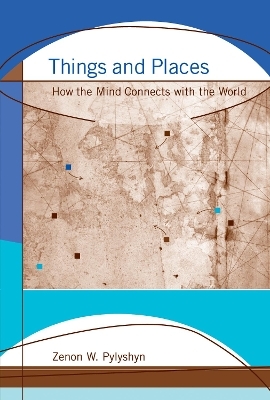
Things and Places
How the Mind Connects with the World
Seiten
2007
MIT Press (Verlag)
978-0-262-16245-6 (ISBN)
MIT Press (Verlag)
978-0-262-16245-6 (ISBN)
- Titel ist leider vergriffen;
keine Neuauflage - Artikel merken
Problems in linking representation and perceived things in the world are discussed in light of the role played by a preconceptual indexing mechanism that functions to identify, reidentify, and track objects.
InThings and Places, Zenon Pylyshyn argues that the process of incrementally constructing perceptual representations, solving the binding problem (determining which properties go together), and, more generally, grounding perceptual representations in experience arise from the nonconceptual capacity to pick out and keep track of a small number of sensory individuals. He proposes a mechanism in early vision that allows us to select a limited number of sensory objects, to reidentify each of them under certain conditions as the same individual seen before, and to keep track of their enduring individuality despite radical changes in their properties-all without the machinery of concepts, identity, and tenses. This mechanism, which he calls FINSTs (for "Fingers of Instantiation"), is responsible for our capacity to individuate and track several independently moving sensory objects-an ability that we exercise every waking minute, and one that can be understood as fundamental to the way we see and understand the world and to our sense of space.
Pylyshyn examines certain empirical phenomena of early vision in light of the FINST mechanism, including tracking and attentional selection. He argues provocatively that the initial selection of perceptual individuals is our primary nonconceptual contact with the perceptual world (a contact that does not depend on prior encoding of any properties of the thing selected) and then draws upon a wide range of empirical data to support a radical externalist theory of spatial representation that grows out of his indexing theory.
InThings and Places, Zenon Pylyshyn argues that the process of incrementally constructing perceptual representations, solving the binding problem (determining which properties go together), and, more generally, grounding perceptual representations in experience arise from the nonconceptual capacity to pick out and keep track of a small number of sensory individuals. He proposes a mechanism in early vision that allows us to select a limited number of sensory objects, to reidentify each of them under certain conditions as the same individual seen before, and to keep track of their enduring individuality despite radical changes in their properties-all without the machinery of concepts, identity, and tenses. This mechanism, which he calls FINSTs (for "Fingers of Instantiation"), is responsible for our capacity to individuate and track several independently moving sensory objects-an ability that we exercise every waking minute, and one that can be understood as fundamental to the way we see and understand the world and to our sense of space.
Pylyshyn examines certain empirical phenomena of early vision in light of the FINST mechanism, including tracking and attentional selection. He argues provocatively that the initial selection of perceptual individuals is our primary nonconceptual contact with the perceptual world (a contact that does not depend on prior encoding of any properties of the thing selected) and then draws upon a wide range of empirical data to support a radical externalist theory of spatial representation that grows out of his indexing theory.
Zenon W. Pylyshyn is Board of Governors Professor of Cognitive Science at Rutgers University. He is the author of Things and Places: How the Mind Connects with the World (MIT Press) and other books. Tom Roeper, Professor of Linguistics at the University of Massachusetts, has studied child language for thirty years, and is a co-author of the Diagnostic Evaluation of Language Variation (DELV), co-editor of Studies in Theoretical Psycholinguistics, and one of the founding editors of Language Acquisition. He has worked on numerous grants from National Science Foundation, National Institutes of Health in the US and other national science foundations in Canada, Europe and Asia. He has lectured all over the world on these topics.
| Reihe/Serie | Jean Nicod Lectures |
|---|---|
| Zusatzinfo | 26 figs. illus. |
| Verlagsort | Cambridge, Mass. |
| Sprache | englisch |
| Maße | 152 x 229 mm |
| Gewicht | 499 g |
| Themenwelt | Geisteswissenschaften ► Psychologie ► Biopsychologie / Neurowissenschaften |
| ISBN-10 | 0-262-16245-8 / 0262162458 |
| ISBN-13 | 978-0-262-16245-6 / 9780262162456 |
| Zustand | Neuware |
| Haben Sie eine Frage zum Produkt? |
Mehr entdecken
aus dem Bereich
aus dem Bereich
Grundlagen, Klinik, Rehabilitation
Buch | Softcover (2024)
Urban & Fischer in Elsevier (Verlag)
CHF 78,40
Buch | Spiralbindung (2022)
modernes lernen (Verlag)
CHF 41,90
Grundlagen, Klinik, Therapie und Verlauf der …
Buch | Softcover (2024)
Kohlhammer (Verlag)
CHF 117,60


